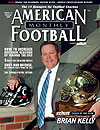Article CategoriesAFM Magazine
|
Helping an Unnoticed Player Get Noticedby: Jeremy ScheuflerOffensive Coordinator, Wichita South High School (KS) © More from this issue High school football offers many great rewards for young men. Unfortunately, due to state guidelines that are different across the board, not all players develop the same or receive the same type of coaching. Occasionally at the high school level players develop late, new kids move into town or those athletically gifted kids walking the halls decide to play football. If this is the case for a senior on your team, then you and he are going to be behind in the recruiting process. This was my first year as offensive coordinator at Wichita South High School and we were in this exact situation. Wichita South in the past has been a dominate power in 6A high school basketball. Football has always fallen on the back burner for athletes. Upon accepting the job our coaching staff immediately hit the hallways trying to get the best athletes on our team. After several practices this year it became very evident we had a stand-out player we convinced to play who was not being recruited. We could tell we had a legit FBS (D-IA) player who the previous staff had not coached up very well. The athlete had all the talent on the football field, it was no our job as coaches to get him noticed. Our first step was to pull the athlete’s transcripts, enroll him in an ACT course and complete the NCAA clearinghouse. Our first job as coaches was to take care of the paper trail. We had to make sure our athlete was eligible. We had to completely restructure the athlete’s schedules to make sure he had accurate credits to qualify for D-IA and D-II football. We then enrolled the student in ACT prep courses and signed him up for the October testing date. Our next step as coaches was networking. I am fortunate to work for a head coach, Tony Johnson, who has numerous D-IA and D-II contacts. Along with him, we got on the phone with all our contacts (college coaches, media outlets and recruiting services). We informed all the collegiate coaches on the player’s attributes (height, weight, position, GPA, ACT transcripts, 40 time, vertical jump, and pro agility) and our game schedule and directions to our contests. Immediately local D-II schools attended our first several games and were very impressed. These schools started letter mailing, school appearances, and invited the athlete to recruiting weekends. Due to the athlete’s financial and family situation, we had to market the player. I, along with Coach Johnson, drove him to collegiate games on Saturdays and helped him fill out recruiting information sheets for colleges. We then started the exposure phase of the recruiting process. We started to work the local newspaper, radio and television media. The athlete had interviews, articles and internet blogs appear about him, along with the exposure our team was getting on our improvement. We then created a two-minute highlight film of the athlete’s outstanding plays. It was critical to make this film a teaser. We wanted to get schools interested by showing off the athlete’s playmaking abilities. We then distributed these films via e-mail. We first emailed area colleges and colleges we were connected too. Within hours of sending this e-mail, our head coach was receiving phone calls and e-mails asking him for more information and game film. It also helps to have a coach on your staff that is gifted with video. If not, your school should have a teacher or student that can help. We then sent two complete game tapes of our player to the schools that were requesting. Our mission had been completed by following these easy steps. The athlete had complete exposure from a variety of colleges at all levels of college football. After the exposure began to pick up, Coach Johnson began a system of following up with college coaches using e-mail, phone and letters. It was a unique system that Coach and I developed to continue to stay on the minds of busy college coaches. We invited coaches to come to the athlete’s basketball games, our banquet, and our off-season conditioning program. We wanted to make this player as available as possible. We noticed something that we hadn’t expected, our younger players saw how we can assist them in getting noticed – the recruitment of this athlete has helped everyone within our program. The appearance of college football coaches recruiting on our campus has helped motivate our current athletes during the off-season workouts. |
|
| HOME |
MAGAZINE |
SUBSCRIBE | ONLINE COLUMNISTS | COACHING VIDEOS |
Copyright 2024, AmericanFootballMonthly.com
All Rights Reserved




